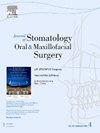Mandibular reconstruction after post-traumatic complex fracture: Comparison analysis between traditional and virtually planned surgery
IF 2
3区 医学
Q2 DENTISTRY, ORAL SURGERY & MEDICINE
Journal of Stomatology Oral and Maxillofacial Surgery
Pub Date : 2025-02-01
DOI:10.1016/j.jormas.2024.102029
引用次数: 0
Abstract
Background
Jaw reconstruction after complex post-traumatic fracture is still a challenge for surgeons using traditional surgery. Virtual surgical planning has proven to be a valid tool for managing these fractures. The aim of this study is to quantitatively evaluate the VSP effectiveness compared to traditional surgery in the management of complex mandibular fractures.
Methods
30 patients with diagnosis of complex mandibular fracture were enrolled and divided in two groups: Group A (virtually planned surgery), The plate was pre-modeled and employed during the surgery; Group B (traditional surgery), the plate was shaped directly during the surgery. Virtually planned and post-operative Computer Tomography were after compared for both the groups to highlight discrepancies in mm.
Results
Fracture surgical reduction was successful without intraoperative complications. In Group A, all the mean discrepancies’ values were <1 mm while in Group B the values were included between 1.36 and 1.94 mm. The mean operative time was 69 min for Group A, while 106 min for Group B.
Conclusions
Fracture virtual reduction and realization of pre-modeled plate are able to guarantee a more anatomically correct reduction and a decrease in operating times. These outcomes translate into a decrease in both short and long-term complications.
创伤后复杂骨折后的下颌骨重建:传统手术与虚拟计划手术的对比分析。
背景:对于使用传统手术的外科医生来说,创伤后复杂骨折后的颌骨重建仍然是一项挑战。虚拟手术规划已被证明是治疗此类骨折的有效工具。本研究旨在定量评估虚拟手术规划与传统手术相比在处理复杂下颌骨骨折方面的有效性:A组(虚拟计划手术),钢板预先建模并在手术中使用;B组(传统手术),钢板在手术中直接成型。两组患者的虚拟计划手术和术后计算机断层扫描结果进行比较,以突出毫米级差异:结果:骨折手术缩小成功,无术中并发症。A 组的平均差异值均小于 1 毫米,而 B 组的差异值在 1.36 至 1.94 毫米之间。A 组的平均手术时间为 69 分钟,B 组为 106 分钟:结论:骨折虚拟还原和预制钢板的实现能够保证解剖上更正确的还原,并减少手术时间。这些结果可减少短期和长期并发症。
本文章由计算机程序翻译,如有差异,请以英文原文为准。
求助全文
约1分钟内获得全文
求助全文
来源期刊

Journal of Stomatology Oral and Maxillofacial Surgery
Surgery, Dentistry, Oral Surgery and Medicine, Otorhinolaryngology and Facial Plastic Surgery
CiteScore
2.30
自引率
9.10%
发文量
0
审稿时长
23 days
 求助内容:
求助内容: 应助结果提醒方式:
应助结果提醒方式:


